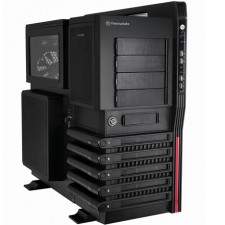 Thermaltake’s Level 10 GT full tower case is a lower cost version of the original Level 10 chassis. The lower price will allow for a wider range of PC enthusiasts and gamers to consider the Level 10 series of chassis as a viable option for their next build. In collaboration between Thermaltake and BMW Group DesignworksUSA, the Level 10 GT has many unique features and design aspects to explore, so that is exactly what we will do!
Thermaltake’s Level 10 GT full tower case is a lower cost version of the original Level 10 chassis. The lower price will allow for a wider range of PC enthusiasts and gamers to consider the Level 10 series of chassis as a viable option for their next build. In collaboration between Thermaltake and BMW Group DesignworksUSA, the Level 10 GT has many unique features and design aspects to explore, so that is exactly what we will do!
About Thermaltake
“While still a relatively young company, established in 1999, Thermaltake is built on unwavering will and dedication to address issues and innovate at the same time for computer enthusiasts and corporate users worldwide . With strong support of Research & Development team standing behind the brand, Thermaltake is committed to never-follow but always-lead.
In past decades, the industrial and technological advancements in different fields have shaped the world we live in today and have also made a big impact on the environment. Thermaltake takes great measures to ensure the product that we produce relieve these impacts by being first to act on 80 PLUS® specification for computer power supply that greatly reduces the amount of electricity that a computer consumes.
Always striving to be the best, we continuously benchmark our performance against the very best internally and externally.
Customers are our greatest asset and Thermaltake does not take that for granted. That is why Thermaltake is the industry leading in customer service and customer support with around-the-clock automated product return service.”
The box that houses the Level 10 GT is very large and continues on with Thermaltake’s use of a black and red theme found on most of their product offerings. The back and front of the box are identical with a front side picture of the Level 10 GT along side a sketch of what we assume to be a BMW’s front end. “driving Inspiration” and “Imagination Without Boundaries” are the slogans applied to the box design. Also printed on the box front and back are mention of USB 3.0 compatability.
The box sides display a multilingual basic feature list and some Level 10 GT branding.
 |
 |
 |
 |
Once the box top is opened you are presented with the usual foam blocks which surround the top and bottom of the chassis. The Level 10 GT comes wrapped in a cloth bag for additional protection.
 |
 |
 |
Inside of the case is a box of accessories which include the following:
- Speaker
- Wire Ties
- Headphone Holder
- Black Screws
- 8-Pin CPU Power Cable Extension
- Warranty Pamphlet
- Users Guide
- 2011 Product Catalog
- Two Keys
 |
 |
Before moving on to the interior and exterior tours, here is the features and specifications list as provided by Thermatake’s web site:
Features
Specifications
The left side of the case has a fairly large window in the upper left section, which is protected with a plastic film cover to ensure it arrives unscathed.. The lower left section features a slide out filter for the included 200mm side intake fan. The upper right area has a mesh area which is removable, has no filter or fan features and is simply for added ventilation and greater access to the 5.25 drive bays . This upper right mesh area has a small rubber plug attached, which when removed provides access to the mounting holes for the headphone holder. The lower right section is where the five slide out hot swap bays are located. The bays have a spring loaded retractable face which provide a grab handle for easy removal. The entire bracket assembly which houses the slide out trays is removable as well.
Worth mentioning here is the “System Security Lock” feature allowing the user to lock down the removal of the side panel. Just to the left of the lock is a lever that controls the louver feature which can be used to control the air flow direction of the side intake fan.
The right side of the case is rather uneventful other than the Level 10 GT branding.
 |
 |
 |
 |
 |
 |
 |
 |
The top of the Level 10 GT features a removable top plate which will reveal another illuminated 200mm fan used for air exhaust. You will need to firmly press a button at the very top rear of the case to release the top cover. We found the top cover design to be a bit restrictive as far as air flow is concerned but luckily the inner mesh filter is easily removable which greatly improved the amount of air being exhausted from of the top of the case. The fan controls are located at the top front area and include switches to control the color and speed of the fans. Additionally two USB 3.0 and the eSATA connections are located here. Just to the right of the switches is another mesh area which can be used for storing small items, there is no option to install a fan here and again is just for ventilation purposes.
 |
 |
 |
 |
 |
Moving around to the rear of the Level 10 GT and beginning at the top area, we find another included fan of the 140mm variety. This exhaust fan is not illuminated and has no filtering system. There is an option to install a 120mm fan in its place if so desired. There are also three rubber grommet protected holes for a water cooling system tubes to pass through. You will also notice a small bracket in the upper left corner, this is used for securing the mouse and keyboard cables to prevent accidental pulling of the cords, as well providing a security system for them at the same time. This bracket has a thumb screw holding it in place, which is accessible from the inside of the case. Finally the top area of the case rear is where the I/O shield gets installed.
Moving down a little we come to the eight PCI expansion slot and their ventilated covers. Just to the right of the covers are two thumb screws which hold a cover plate used to further secure an expansion card after it is installed. Just to the right of that is additional ventilation holes.
The rear bottom area of the case is where the power supply opening is located. There is a slide out filter which will rest beneath the power supply once it is installed and to the right of the PSU opening is another cable securing bracket for the power cord.
 |
 |
 |
 |
Continuing on and laying the case on it’s side we can explore the bottom area. There are four adjustable hard plastic feet which have two rubber inserts each. The rubber feet inserts provide an excellent skid proof design for the case and also provide good anti-vibration qualities. The feet are adjustable to either a parallel or horizontal position. The pictures below also provide a good look at the power supply filter previously mentioned. Also at the bottom is the button used to release the left side panel.
 |
 |
 |
 |
We’ll finish up the exterior tour of the Level 10 GT with a look at the front panel area. The top area has four 5.25 bay covers which are easily removed by using the pinch levers on each side of them. We found that the easiest way to remove the covers is by pinching just one of the levers and swinging the cover out instead of pinching both levers and trying to pull it straight out. All of the bay covers feature a built in foam filter that can be removed for cleaning. To the right of the 5.25 bays is where the power switch, reset switch, HDD activity LED, four USB 2.0 connectors and the headphone/microphone jacks are located.
Moving down a bit we come to the single 3.5 drive bay cover which has all the same qualities and function of the 5.25 covers. To the left of the 3.5 bay cover is the HDD tray lock. In order to remove one of the hot swap drive trays this will need to be in the unlocked position and the corresponding numbered button below must also be pressed.
The bottom of the front panel has all the buttons for the hot swap bays removal as well as a red highlight strip running down the right side.
 |
 |
 |
 |
There is much to discuss when diving inside of the Level 10 GT’s interior so let’s get started!
We start our tour of the interior by removing the right side panel, which is accomplished by removing two thumb screws and sliding the panel rearward. The panel is recessed by design to allow cable clearance behind the motherboard tray area. Even with the recessed side panel design, any thick 20/24 pin ATX power supply lead will be a tight fit. With a case this size, and at this price, we would have expected a huge amount of space here. There is certainly ample opportunity to provide more room given the sheer girth of the Level 10 GT. On the bright side however, Thermaltake did a fantastic job of cable management with all of the case’s included cabling, everything is right where it should be and is routed very well.
One feature we really liked was that all of the drive bays are fed power with a single lead, so a single power source from your PSU is all that’s needed to power up all five drive bays.
There are a total of seven rubber oval shaped grommet style cable management holes to work with, along with two additional cut outs just to the right of the drive bays. There should be ample opportunity to route cables for any conceivable configuration.
The 5.25 device locking mechanism brackets are accessed through the right side of the case as well, an interesting choice here as conventional wisdom usually locates these locking brackets on the left side. These brackets are quite simple in operation, simply slide a device in and slide the bracket forward to secure it.
 |
 |
 |
 |
 |
 |
In order to access the main interior area of the Level 10 GT, the lock located on the side panel must be in the unlocked position, and the button located at the bottom of the case must be pressed. After that simply swing the door open and you have access. Furthermore, should you desire to remove the panel completely simply lift it up and off of the hinges. When doing so you will notice that the main body of the case and the left side panel have mating electrical contacts which eliminates the need to unplug the side panel’s fan. We did come across one minor issue here, when the side panel is opened and the electrical contacts are separated, you lose your fan color settings and it reverts back to default. However, once the panel is reinstalled you’re just a couple of button clicks away from your preferred settings.
Also in the first picture below you can get a good look at the louver bracket which is adjustable and provides the ability to guide air flow at interior components.
 |
 |
 |
The need to route a USB 3.0 cable out the back of the chassis will not be an issue here as the case comes with a motherboard header style cable. The front panel connectors are standard fare for most chassis with the power, reset, HDD LED and power LED cables all present and accounted for. There are two USB 2.0 front panel motherboard header connectors, as well as a single front panel audio connector. The audio cable has the option of using the HD audio or AC97 function depending on which of the two options are available with your motherboard. Also included is the eSATA connection cable and a 4-pin molex connector which powers the fan controls at the top of the case.
 |
 |
 |
 |
The motherboard tray area has an extremely large CPU cooler access hole which will save a lot of time when a CPU cooler is changed out. Each threaded hole for a motherboard mounting peg is marked with the form factor it coincides with, taking the initial guess work out of the task.
The bottom area has PSU support brackets used for added support and give the entire area a very solid feel once the PSU is installed. In front of the PSU mounting area there is a place to add an optional 120mm fan. You will also notice in the bottom area of the motherboard tray several different cable routing options depending on the length of the PSU you are using.
The rear portion of the interior features a 140mm exhaust fan and the eight expansion slot covers. All of the expansion slots are provided with black thumb screws for mounting add on cards.
 |
 |
 |
 |
As mentioned during the exterior tour the interior top section has another illuminated 200mm exhaust fan. If you prefer water cooling, this area is well suited for a radiator if you remove the fan. You have the option of installing either a 120mm or 240mm Radiator here. If you decide to install a radiator we highly recommend removing the inner wire mesh filter from the top panel to aid in air flow to the radiator.
Having a look at the drive bay area from the inside of the case gives you a good look at the filtering applied to all of the bay covers as well as the drive guides/supports. There is also a built in bracket for installing a 2.5 SSD drive located at the bottom of the 5.25 drive bay area.
 |
 |
 |
Moving our attention to the front of the case we begin by removing the front bezel. The bezel is easily removable by grabbing it at the bottom and pulling outward. Once the front bezel is removed you expose the wiring for the front panel connections and you get a good look down the barrel of the 5.25 drive bays. Also revealed is the last of the three illuminated 200mm fans, this one obviously being an intake fan.
 |
 |
 |
 |
 |
Installing both 5.25 drives and 3.5 drives is a snap with the Level 10 GT. Beginning with the installation of a 3.5 hard drive, simply drop a drive into the tray of your choice, line up the mounting holes and secure it using the provided HDD mounting screws. Once that is accomplished, slide the tray back in until you feel a reassuring click which means you have correctly engaged the power connection. Run your HDD data cable from the drive to your motherboard and the task is complete. As previously mentioned a pre-installed SATA power source for all five drive bays is included.
Installing a 5.25 device is just as easy. Just slide it in through the front of the case and align it with the lock lever while sliding the lever forward…..Done!
If you desire additional screws to be used during the 5.25 drive installation you can remove the mesh cover over the left side of the mounting area. This is accomplished by removing six screws in all, three from the main compartment area and three from behind the front bezel. If you would like to open up the 3.5 drive bay area even further, the entire bracket assembly which houses the trays can be removed with four screws, two from the main compartment and two more behind the front bezel.
 |
 |
 |
 |
 |
 |
We decided the best way to show off all the lights was to make a quick video for your enjoyment!
If you are a fan of a little bling for your case, you will like the LED lighting feature and all the different options at your disposal.
The Thermaltake Level 10 GT is a very unique case to say the least and while style and looks are certainly subjective to the individual, the Level 10 GT will certainly appeal to the masses as far as looks go. The case is feature packed as a case selling for roughly $270 USD should be. A few of the features that stood out in our minds were the built in single wire SATA power connector, the hot swap drive bays, the ease in which both 5.25 and 3.5 drives can be installed and of course the lighting effects. The biggest problem we had with the case is the lack of cable management room between the motherboard tray and the right side panel. Although an attempt was made to accommodate this problem by recessing the side panel itself, we felt an opportunity was missed to provide even more room in this area.
All and all the Thermaltake Level 10 GT case was a pleasure to work with and will provide almost any system build both quality and the looks to match. If you have been looking for a higher end case that has all the features you could ask for, looks great and has just the right amount of flare then the Thermaltake Level 10 GT could be just what you are looking for.
The Level 10 GT received a 9/10 and an OverclockersTech Gold Award!








 Posted in
Posted in 

